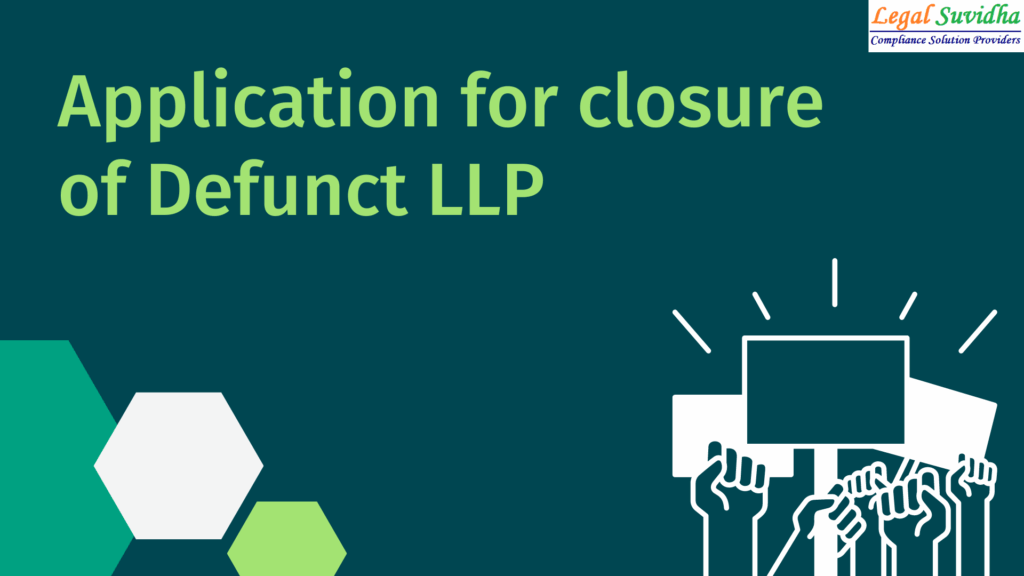CLOSURE OF DEFUNCT LLP
When a limited liability partnership (LLP) hasn’t conducted any activity for a year or more, it can be easily dissolved by removing its name.
An LLP can also be wound up by a voluntary winding up or by a tribunal winding up. A defunct LLP, however, that has not conducted any business or operations for a period of one year, or more may be struck off the LLP register.
The process for the closure of a defunct LLP is complicated and far-reaching.
What is Defunct?
Defunct describes a corporation that has filed for bankruptcy and ceased to exist, regardless of whether it is publicly traded or privately held. The term ‘defunct’ typically describes something that is no longer present, active, or used. It may define policies, procedures, companies, associations, brands, or customs.
Who Can Sign the Application for Closure of a Defunct LLP?
The designated partners must sign the application for the closure of a defunct LLP with the assent of all partners. The chosen partners must also sign affidavits and indemnities as the LLP Rules require.
What are the legal Provisions for the closure of an LLP or Strike off an LLP?
Rule 37 of the Limited Liability Rules, 2009 deals with the striking-off name of Defunct LLP. Defunct means those LLPs which are not functioning or not operating.
Hence, it is a pre-requisite that LLP must be defunct for at least 1 year before applying for closure. It provides that “where a limited liability partnership is not carrying on any business or operation for a period of one year or more, such LLP can make an application to the Registrar, with the consent of all partners of the limited liability partnership for striking off its name from the register“.
Limited Liability Partnership (Amendment) Rules, 2017 added sub-rule 1A after sub-Rule 1 of Rule 37 as follows:
i. The LLP shall file overdue returns in Form 8 and Form 11 up to the end of the financial year in which it ceased to carry on its business or commercial operations before filing Form 24;
ii. enclose along with Form 24,—
(a) a statement of account disclosing nil assets and nil liabilities, certified by a Chartered Accountant in practice made up to a date not earlier than 30 days of the date of filing of Form 24; (b) an affidavit signed by the designated partners, either jointly or severally, to the effect:
(i) that the Limited Liability Partnership has not commenced business or where it commenced business, it ceased to carry on such business from ………….(dd/mm/yyyy);
(ii) that the limited liability partnership has no liabilities and indemnifies any liability that may arise even after striking off its name from the Register;
(iii) that the Limited Liability Partnership has not opened any Bank Account and where it had opened, the said bank account has since been closed together with certificate(s) or statement from the respective bank demonstrating closure of Bank Account;
(iv) that the Limited Liability Partnership has not filed any Income-tax return where it has not carried on any business since its incorporation, if applicable.
(c) a copy of the acknowledgment of the latest Income-tax return;
(d) copy of the initial limited liability partnership agreement, if entered into and not filed, along with changes thereof in cases where the Limited Liability Partnership has not commenced business or commercial operations since its incorporation.
Documents required for closure of LLP
The following documents are required for the closure of LLP –
- Detailed Application for Closure of Limited Liability Partnership(LLP);
- An affidavit executed either individually or jointly by all the Partners;
- Consent of all the partners;
- Statement of accounts showing Nil assets and liabilities certified by a Chartered Accountant in practice not older than 30 days from the date of filing of an application
- A copy of the acknowledgment of latest Income Tax Return; > Initial LLP Agreement along with all supplementary agreements, if any.
How to Handle the Closing of a Deceased Company
The closing of a deceased company is often complicated by the fact that the owners are not involved in the closing process. It is the job of the remaining partners to close the business and wind down its operations. This can be done on their behalf by an agent, or the partners themselves can complete the closing process. When closing a deceased company, you will need to coordinate the following steps:
- Determine which creditors are owed money by the company and who you will pay first
- Determine which owners are still owed money by the company and who you will pay first
- Determine the company’s assets and liabilities and pay out the proper amount
- Finalise the company’s books and records.


![Received an Income Tax Notice in India? Don’t Panic — Here’s Exactly What to Do [2025 Guide] 1 Income Tax Notice](https://legalsuvidha.com/wp-content/uploads/2025/12/Income-Tax-Notice.png)
![Cyber Crime FIR in India: How to File Complaint for Online Fraud, Banking Fraud & Digital Harassment [2025 Guide] 2 Cyber Crime Complaint](https://legalsuvidha.com/wp-content/uploads/2025/12/Cyber-Crime-Complaint.png)
![Trademark Infringement in India: How to File Legal Action & Protect Your Brand [2025 Guide] 3 Tradenark Infrigement](https://legalsuvidha.com/wp-content/uploads/2025/12/Tradenark-Infrigement.png)
![Property Title Verification in India: How to Check Clear Title in 7 Steps [Avoid Property Fraud – 2025 Guide] 4 Property Titles Verification](https://legalsuvidha.com/wp-content/uploads/2025/12/Property-Titles-Verification.png)



